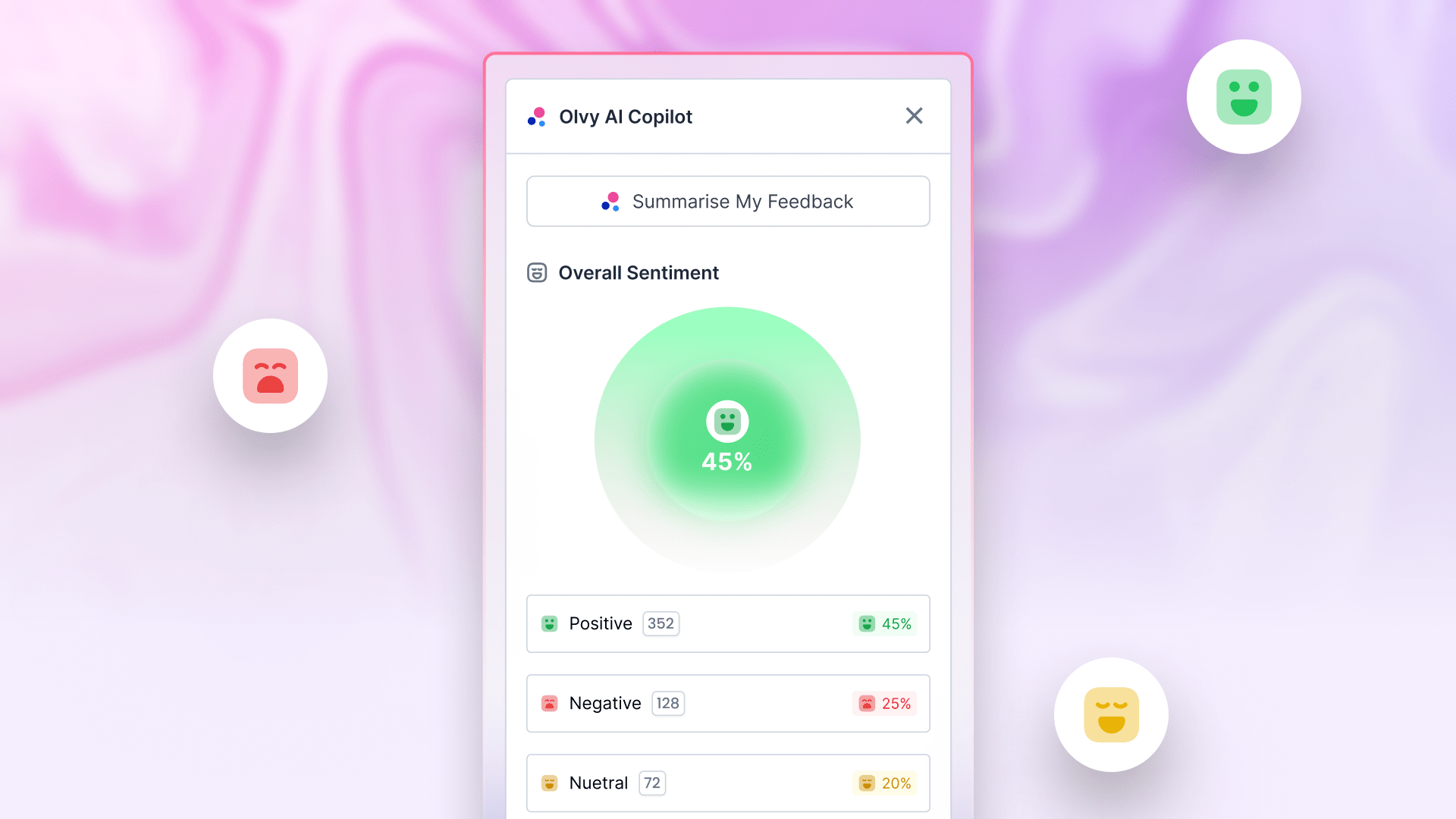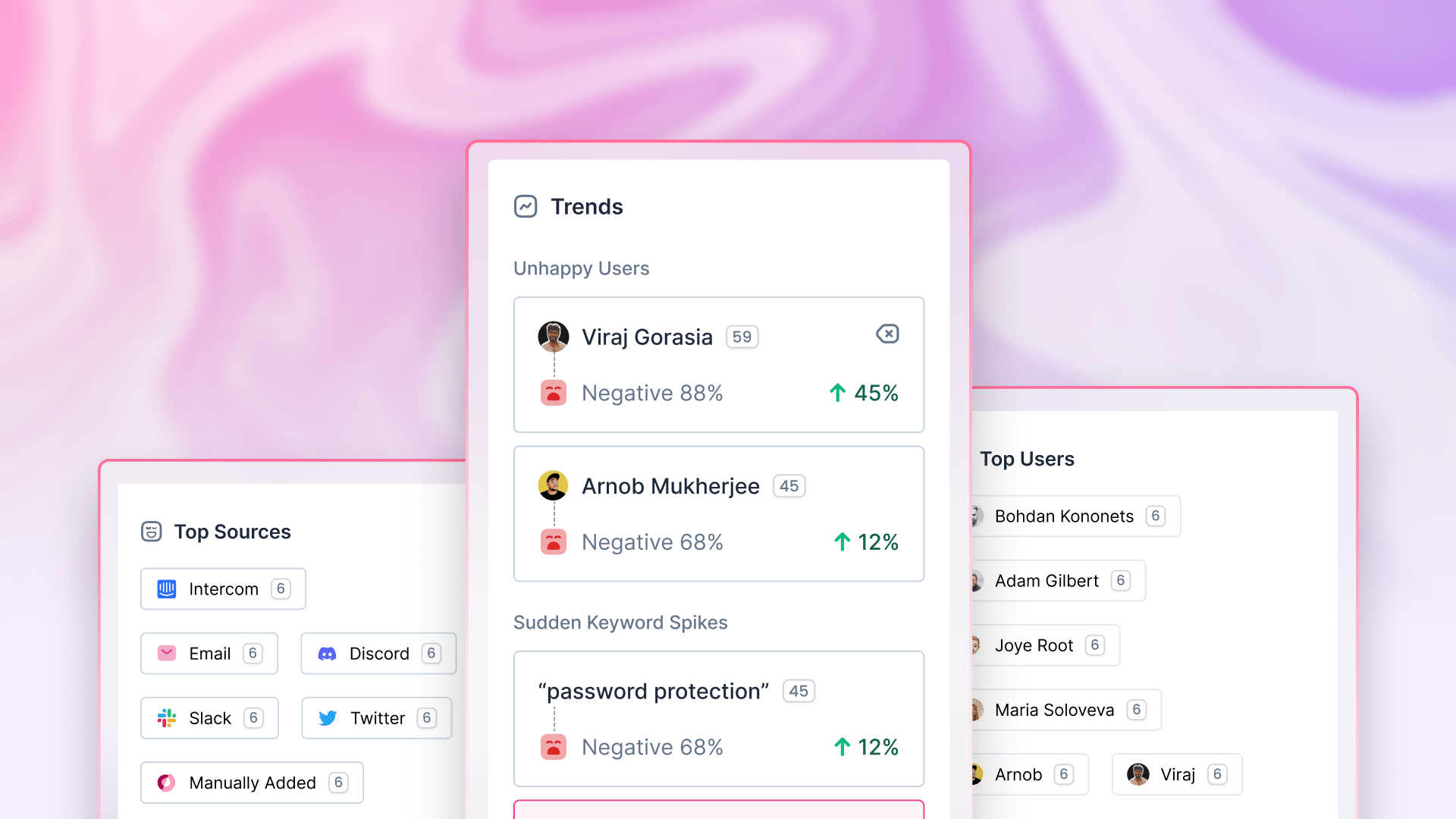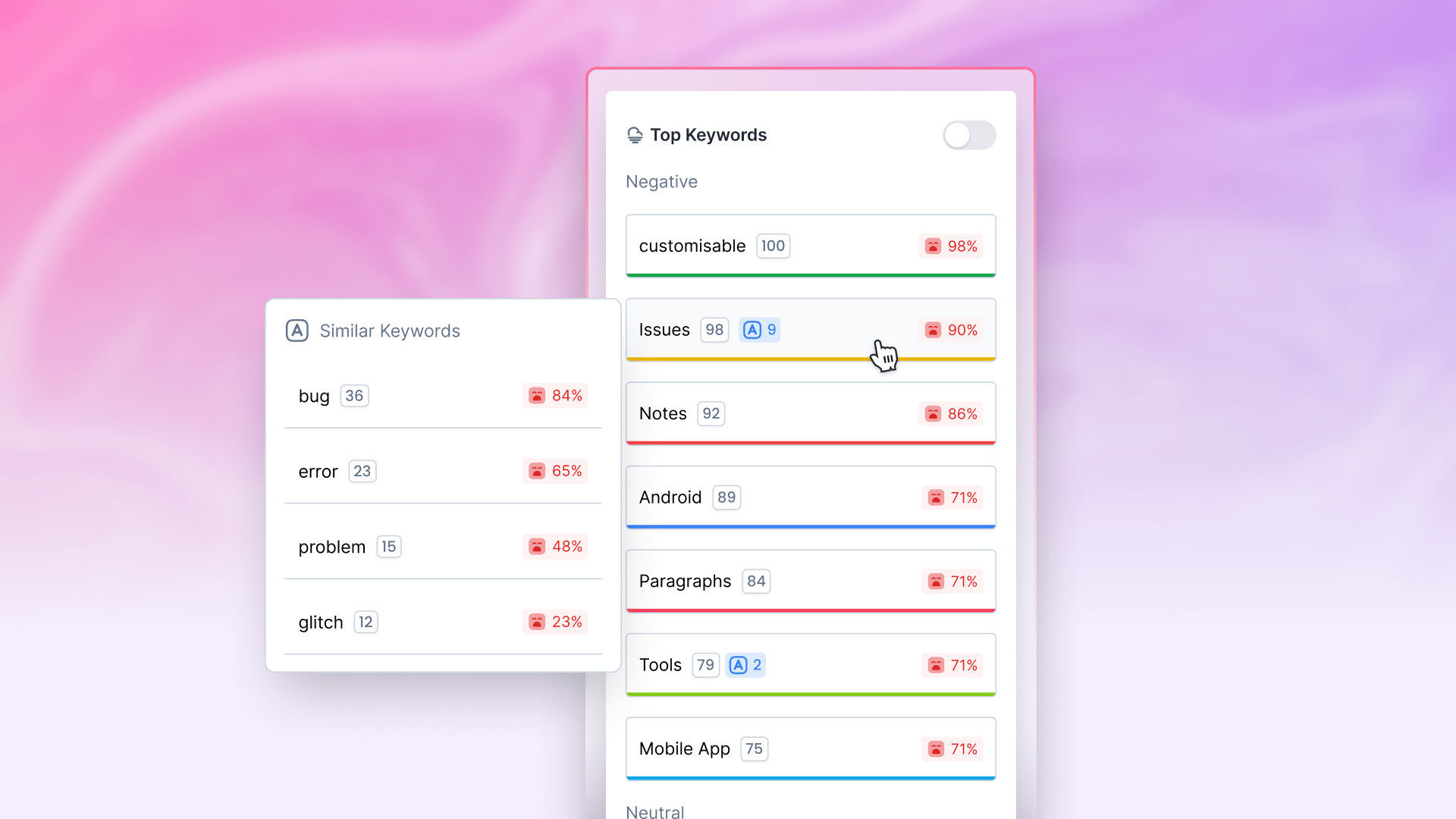Do you know what it takes to build great products? Listening to users diligently. Understanding what your users like and dislike about your product is crucial to improving it, addressing issues, and creating new features that better meet their needs.
User feedback can also help you build stronger customer relationships by demonstrating your commitment to providing an exceptional user experience. However, analyzing tons of user feedback can be a daunting task.
In this blog, we explore the importance of user feedback, how you can analyze tons of user feedback to improve your products, and a lot more.
So, let's get started.
What Is User Feedback?
User feedback refers to information and opinions from the users of your product about what they like or dislike in the product and the parts where they faced issues or anything that they want you to improve. Feedback can be in any form on any platform, such as comments on social media, website reviews, surveys, and direct messages from users.
User feedback is important as it helps you understand what exactly your users need and expect from you. It can help you make improvements, address issues, create new features, and more.
User feedback can also help build stronger relationships with users as you can show them how much you value their opinions by responding promptly and transparently. In addition, it shows how committed you are to providing a great user experience.
Why Should You Listen to User Feedback?
User feedback is essential to help you build a successful product, as nothing can be better than asking your users what they want. Here are some reasons why you should listen to your users:
1. Identify Areas for Improvement
User feedback gives you insights into what works well and what needs improvement in your product. In addition, analyzing feedback can help you identify trends, issues, and pain points that may have gone unnoticed otherwise. This way, you can make informed decisions about what changes to be made to improve the overall product.
2. Enhance Customer Satisfaction
Listening to user feedback allows you to make your users feel heard and valued. You can enhance customer satisfaction by showing them how much you appreciate their opinions. It will, in turn, reduce customer churn and increase NPS and customer loyalty.
3. Foster Innovation
Listening to user feedback gives you a fresh new perspective to approach a user problem or even, at times, introduces you to a new problem you haven't thought of. This way, user feedback fosters innovation by adding a unique perspective to approach any existing problem or build new features.
4. Improve Brand Reputation
When users see that you actively listen and respond to their feedback, it will build trust and a positive reputation for your brand. Users mostly trust and use products that have a good brand reputation.
5. Drive Business Growth
Leveraging user feedback can help you drive business growth by making informed product decisions. When you create products that meet the needs and preferences of your customers, you attract new customers, retain existing ones, and ultimately, drive your business growth.
How to Make Sense Out of Tons of User Feedback?
Analyzing user feedback can be daunting, especially when dealing with large volumes of data. However, there are several ways by which you can make sense out of tons of user feedback, and some of them are:
- Using Data analysis tools that analyze texts, visualize data, and survey tools helps you identify trends, patterns, and sentiments in feedback.
- Categorizing feedback by topic or feature to identify areas that require improvement and prioritizing feedback to invest resources in changes that will impact users the most.
- Engaging with users directly through surveys, focus groups, and user testing to get more context and clarification on feedback is made easy by tools like Olvy that lets you communicate with users on their feedback.
- Extracting valuable insights by collaborating across departments to improve and enhance user experience further.
Ways to Analyze User Feedback
Analyzing user feedback is crucial for businesses aiming to improve their products or services. By understanding the feedback users provide, companies can identify areas of improvement, prioritize issues, and take necessary actions to enhance their offerings. There are two ways to analyze user feedback - manual analysis and analysis using Olvy.
Analyzing User Feedback Manually
Analyzing user feedback manually is a traditional method that involves going through all feedback sources individually and manually sorting out similar feedback to understand the patterns and prioritize issues based on the analysis. Here are the steps involved in manual analysis:
1. Going to All Feedback Sources One By One
The first step in the manual analysis is to identify all feedback sources where users have provided their feedback. This can include social media platforms, review websites, customer support emails, chatbots, etc.
2. Manually Collecting Feedback From All Sources in One Place
Once the feedback sources are identified, the feedback needs to be collected from each source and compiled in one place. This can be done by copying and pasting the feedback or emailing it.
3. Sorting Out Similar Feedback Yourself
After compiling all feedback, similar feedback needs to be sorted out manually. This can be time-consuming, especially if there is a large volume of feedback. The process involves identifying and grouping together feedback that addresses similar issues or topics.
4. Understanding and Finding Patterns in Similar Feedback
Once the similar feedback is sorted out, the next step is understanding and finding patterns. This involves analyzing the feedback to identify common themes or issues that users consistently mention. This can provide valuable insights into areas where the product or service can be improved.
5. Prioritizing Based on the Analysis
Finally, based on the analysis, the feedback needs to be prioritized. The issues that are identified as most important or urgent should be given higher priority and addressed first. This helps businesses to improve their offerings and address the most pressing concerns of their users.
Analyzing User Feedback Using Olvy
Using Olvy AI Copilot for feedback analysis takes off most of your manual work. In addition, it helps optimize your feedback analysis by providing sentiments, keywords, top sources, and users beforehand.

1. Feedback Collection From Multiple Sources
With Olvy, you just need to integrate all your feedback sources, such as Slack, Discord, Telegram, Crisp, Intercom, Microsoft Teams, etc., and sit back. All your user feedback will automatically be collected in your Olvy Workspace, or you can also push feedback from any source. You can also forward significant feedback users' emails to your unique Olvy email, and it'll be captured as feedback in your workspace. Not only this, but it also has a Chrome extension which means you can push feedback from any web page or your sales calls to Olvy immediately. Olvy also has a feedback widget that lets you capture real-time user feedback. And all these things aren't possible manually.
2. Feedback Summarization
Olvy lets you summarize all your user feedback, so you don't have to manually go through all the user feedback to make sense of tons of feedback. Then, based on the feedback summary, it also gives you suggestions on what you should do next. This really solves half of your problem and saves a lot of time and effort that you would have needed to invest in going through all the feedback one by one.
Summarize User Feedback
3. Sentiment Analysis
Olvy also gives you sentiment analysis that isn't possible to get manually. For example, it shows you the overall users sentiments that users have around your product and individual feedback sentiments as well.

4. Keyword Analysis
Olvy shows you a list of keywords mentioned in your feedback categorized based on sentiments. It helps you filter out feedback based on the keywords, which means you can group similar feedback and identify common themes and patterns your users talk about.
Advanced Keyword Analysis
5. Top Feedback Sources and User Interaction
Olvy also tells you the top sources from where you receive feedback most of the time and the users who give most of the feedback or talk more often about your company. This way, you can identify the type of your users and the platform they use the most to communicate with you.

6. Categorize and Prioritize User Feedback
Once all your user feedback is captured in one place, you can categorize your user feedback based on keywords, sentiments, most pressing issues, etc., and prioritize tasks on your roadmap by creating tasks or issues.

Why Should You Use Feedback Analysis Tool?
Analyzing user feedback is crucial if you want to improve your product and provide a better user experience. However, manual analysis of feedback can be a time-consuming and daunting task. This is where feedback analysis tools come in. Here are some reasons why you should use a feedback analysis tool:
1. Save Time and Effort
A feedback analysis tool can help you save time and effort by automating the process of collecting and analyzing feedback. Using a tool can help you quickly and efficiently collect feedback from different sources, easily identify patterns, and prioritize issues based on the analysis.
2. Prioritize Tasks in the Roadmap
Using a feedback analysis tool, you can prioritize tasks in the roadmap based on the importance and urgency of the feedback. It helps you address the most pressing concerns of your users and improve the product accordingly.
3. Understand Users Better
A feedback analysis tool can help you better understand your users by providing insights into their preferences, pain points, and expectations. It gives you scope for improvements to better meet the user's needs and increase customer satisfaction.
4. Get Real-Time Feedback
A feedback analysis tool can provide you with real-time user feedback. This helps you quickly identify and address any issues or concerns your users may have and improve your product.
5. Measure the Effectiveness of Changes
A feedback analysis tool can help measure the effectiveness of changes made to the product based on user feedback. It enables you to determine whether your efforts to address user concerns have succeeded and make further improvements as needed.
6. Identify Trends and Benchmark Against Competitors
Using a feedback analysis tool, you can track changes in user feedback over time, identify trends and patterns, and benchmark the performance against competitors. It helps you gain valuable insights into the strengths and weaknesses of your product and make improvements accordingly.
Now the Ball Is in Your Court
Now it's time to not miss out on any feedback and capture all the user feedback in one place to get precise and actionable insights. If you do things manually, there are higher chances you'll skip a few important things your users are talking about. But if you don't want such a thing to happen and want to stay on top of your users' nerves, use a feedback analysis tool. You have to decide for yourself.


